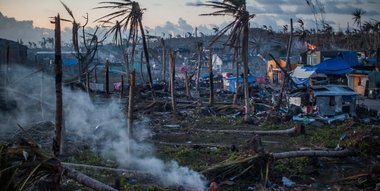- Wydanie oryginalne
- Poprzedni odcinek S41E05 - Great Cathedral Mystery
- Numer S41E06
-
Dyrektorzy
Gail Willumsen
Jill Shinefield
-
Pisarz
Gail Willumsen
- Kraj Stany Zjednoczone
- Gatunek Dokument
-
Linki zewnętrzne
StronaTVDB
Strona IMDB
Strona TheMovieDB -
Ostatnia aktualizacja
24 novembre 2023 - 05:35
na 11 bazach danych -
Killer Typhoon
It was the strongest cyclone to hit land in recorded history. On November 8, 2013, Typhoon Haiyan slammed into the Philippines, whipping the low-lying and densely-populated islands with 200 mph winds and sending a two-story-high storm surge flooding into homes, schools, and hospitals. It wiped villages off the map and devastated cities, including the hard-hit provincial capital Tacloban. Estimates count more than 5,000 dead and millions homeless. What made Haiyan so destructive? Meteorologists charged with tracking Pacific storms reveal why the Pacific is such fertile ground for cyclones, and NOVA’s film crew documents how conditions dramatically deteriorated in the storm’s aftermath, as impassable roads and shuttered gas stations paralyzed the critical relief effort, leaving food, water, and medicine to pile up at the airport. Disaster preparedness experts scramble to understand why the Philippines was so vulnerable. As climate change and sea level rise threaten millions of the world’s most impoverished people with stronger, and perhaps more frequent, storms, how can we prepare for the next monster typhoon?


Odcinki (23)
Aktorzy
Podobne spektakle (10)
 NOVA Wonders
NOVA Wonders
 Horizon
Horizon
 Atlas
Atlas
 Naked Science
Naked Science
 A História em Imagens
A História em Imagens
 Bitz and Bob
Bitz and Bob
 Emily's Wonder Lab
Emily's Wonder Lab
 Oddly Satisfying Science
Oddly Satisfying Science
 Killers of the Cosmos
Killers of the Cosmos























